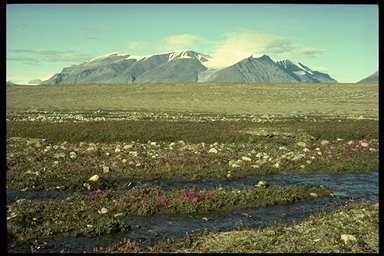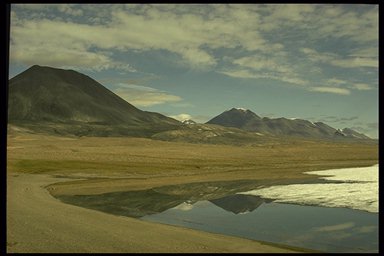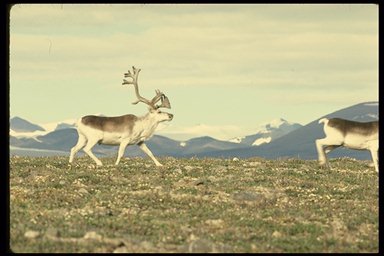
TOP OF THE WORLD
This is as far away as you can get in Canada. Here is a land of desolation and splendour on a grand scale. But it is also a land of intimate, fragile beauty - of delicate arctic poppies vibrating in the breeze, of miniature forests of lichens and heather, of subtle pastel shades and heady aromas.

THE LAND:
Most of this region is desert - a lifeless frozen land. The Ice Age still holds sway over this land, and massive ice caps cloak much of this region. On Ellesmere Island, the ice cap is 2100 metres above sea level and hundreds of metres thick. The rugged peaks of the Innuitian Mountains, among the highest in Canada, pierce the ice. Like hands groping to touch, glaciers extend icy fingers toward fiords reaching inland.

The climate is "damn" cold. Even in July, the largely ice-covered seas refrigerate the land. The region is dry, receiving about the same precipitation as the Sahara.
VEGETATION:
Although most of the region is ice and rock, there are a few areas, called Arctic thermal oases, that have remarkably high biological productivity for the latitude. Although they cover less than two percent of the land, they are of critical importance to all life in the region. During the brief summer of continuous 24-hour sunlight, these oases burst into bloom in a frantic rush to complete life cycles before the onset of winter. In the most luxuriant oases, heathers and blueberries are found. More common are meadows of sedges and mosses, along with herbs that grow in dense cushions and mats. The entrances to animal dens, the ground around decomposed carcasses, old campsites and other "fertilized" spots stand out as having lusher, more colourful vegetation than the surrounding areas.
WILDLIFE:
This region has few species of animals. Land mammals include Peary caribou, muskox, wolf, arctic fox, ermine, arctic hare and collared lemming. Conspicuous land birds include the horned lark, hoary redpoll, snow bunting and willow ptarmigan.
Peary caribou are smaller and paler than barren-ground caribou. Unlike their mainland relatives, they do not undertake long seasonal migrations or travel in huge herds. They occur in small scattered groups, sometimes in the most seemingly inhospitable habitats. Severe winters in recent years have caused the number of Peary Caribou to drop alarmingly.

Snow geese, eiders, oldsquaw and a host of shorebirds nest on the grassy tundra. The arctic tern also nests here on the shores of lakes and along beaches. This champion migrator follows the sun of summer, never knowing a day of winter in its life.
STATUS OF NATIONAL PARKS
Ellesmere Island National Park Reserve (37 775 km2), Canada's second largest national park, represents this natural region. A land of ice, it is dominated by hundreds of glaciers. Mount Barbeau (2600 m), the highest mountain in eastern North America, towers over vast ice fields.The long bitterly cold winters, brief cool summers and low precipitation have created polar desert conditions throughout much of the park, with little vegetation or wildlife. However, lowland areas, such as the one surrounding Lake Hazen, the most northerly lake in Canada, are relatively lush. In these thermal oases, arctic hare often congregate in groups of hundreds. Small herds of muskox and Peary caribou, a few wolves, numerous arctic foxes and about 30 species of birds thrive in meadows of lush grasses and bright arctic flowers.
Hundreds of archaeological sites in the area tell of ancient Inuit peoples who passed this way 4000 years ago. The remains of Fort Conger, a scientific research base established in 1881, is a site of historic significance. Wooden shacks built by the Arctic explorer Robert Peary, of North Pole fame, still stand on the site.
